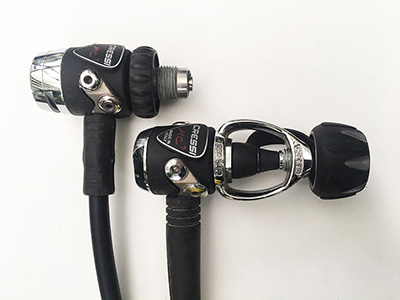A DIN or a Yoke Regulator? Itís Time To Know The DifferenceContents of this Issue: Aiyanar Beach & Dive Resort, Anilao, Philippines Fiji, Molokai, Little Corn Island, St. Eustatius How You Can Purge Plastic from the Ocean Your Dive Boat Sinks Before You Get There Sharks are Not Pussycats as Shark Divers Discover The Etiquette of Tipping on Dive Trips: Part II Parents Sue PADI over the Death of Their 13-Year-Old Son Failing to Turn Your Tank On All the Way Is ďSimply StupidĒ The Potential of a Liveaboard Fire New Fire Safety Regulations Coming for US Liveaboards American Diver Dies in Red Sea Aggressor I Fire Those Underwater Photo Courses A DIN or a Yoke Regulator? Itís Time To Know The Difference Editorial Office: Ben Davison Publisher and Editor Undercurrent 3020 Bridgeway, Suite 102 Sausalito, CA 94965 from the November, 2019 issue of Undercurrent
There was a time when every regulator was fitted to a tank valve by means of a yoke fitting (officially known as an International A-Clamp). The tank valve has an O-ring, and most divers have been affected by annoying leaks and blown O-rings because these can wear and fray. A DIN connection solves this problem, and that's why regulators are now available in both DIN and yoke configuration. A DIN-fitting regulator has a permanently captive O-ring and screws securely into the tank valve. Technical divers prefer them because the O-rings rarely wear or blow, and the simpler shape of the DIN regulator, devoid of the yoke, means there's less likelihood of entanglement with lines and gear.
With the rising DIN regulator popularity driven by the technical diving community, you may think your American-bought yoke regulator will not fit tanks provided overseas. Don't worry. Most standard-pressure DIN tank valves worldwide are convertible and accept a yoke regulator by means of a screw-in slug. Some of these adapters offered by dive operators in distant countries look a little tired, so prudent divers carry their own adaptor -- they cost only a few dollars at your local dive shop and take up no space in your carry-on. If you decide to buy a new DIN-fitting regulator, you may have problems in the U.S. or Caribbean because most tanks are A-clamp-fitting only and not convertible. So you'll need to add a yoke adapter, also available from your dive shop. Both DIN and yoke-fitting regulators are usually made from chromed brass. If you use a yoke adapter made of lightweight aluminum, don't leave it on your DIN regulator if you're storing it for long periods. In the presence of seawater, electrolysis between different metals can make the yoke adapter impossible to remove later. A cautionary note: In many European Union countries (but not the U.K.), tanks designated for nitrox have a different thread (M26) than those for air (M25). Check with your dive operator abroad to make sure they have tanks that are used for both air and nitrox, in which case they'll be suitable to use with either DIN or yoke regulators. M26 DIN-fitting regulators are normally color-coded green, are compatible with 100 percent oxygen, and are usually the exclusive province of technical divers. -- John Bantin |

I want to get all the stories! Tell me how I can become an Undercurrent Online Member and get online access to all the articles of Undercurrent as well as thousands of first hand reports on dive operations world-wide
| Home | Online Members Area | My Account |
Login
|
Join
|
| Travel Index |
Dive Resort & Liveaboard Reviews
|
Featured Reports
|
Recent
Issues
|
Back Issues
|
|
Dive Gear
Index
|
Health/Safety Index
|
Environment & Misc.
Index
|
Seasonal Planner
|
Blogs
|
Free Articles
|
Book Picks
|
News
|
|
Special Offers
|
RSS
|
FAQ
|
About Us
|
Contact Us
|
Links
|
3020 Bridgeway, Ste 102, Sausalito, Ca 94965
All rights reserved.

 Another plus: DIN-fitting regulators with the required number of extra screw-threads are rated for use on suitable tanks with higher pressures (up to 4350 psi), so you can make longer dives. (Never use a yoke regulator on one of these high-pressure tanks, even if you can find an adapter to fit it, because the pressure is too high to be considered safe.)
Another plus: DIN-fitting regulators with the required number of extra screw-threads are rated for use on suitable tanks with higher pressures (up to 4350 psi), so you can make longer dives. (Never use a yoke regulator on one of these high-pressure tanks, even if you can find an adapter to fit it, because the pressure is too high to be considered safe.)